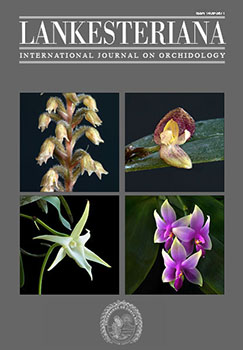To be, or not to be a <i>Stelis</i>
DOI:
https://doi.org/10.15517/lank.v19i3.40082Palabras clave:
convergence, evolutionary history, floral morphology, generic circumscription, Pleurothallidinae, pollinator adaptationResumen
Despite the availability of multiple sources of evidence and consistency in the support for a broadly circumscribed Stelis Sw. (Orchidaceae: Pleurothallidinae), some authors continue to be hesitant in its use. It is certain that the more typical species of Stelis, with their triangular, flattish flowers with very short fleshy petals and lip, form a monophyletic group that is easily recognized. However, it is likewise undisputed that they are not an isolated lineage in the subtribe and that several groups of species with a similar vegetative habit but that lack the typical Stelis flower are in fact very close relatives, sharing a relatively recent common ancestor. Those species groups need to be classified in a way that also reflects their own evolutionary history, and alternatives to a broadly circumscribed Stelis are possible yet neither straightforward or practical at this time. An infrageneric classification for the whole group is provided here in an attempt to clarify which species actually belong where in this highly complex affinity. Emphasis is made on the difficulty of diagnosing the less typical members of each proposed subgenus or section, and on the importance of floral convergence and divergence as a result of pollinator adaptation. As here defined, Stelis is the largest genus in the Pleurothallidinae, with 1243 species.
Descargas

Descargas
Publicado
Cómo citar
Número
Sección
Licencia
Conforme con las Políticas de Acceso Abierto promovidas por la Universidad de Costa Rica, los derechos de autor de todos los artículos publicados en Lankesteriana se encuentran bajo una licencia Creative Commons y pueden ser descargados gratuitamente. Los derechos de autor y de publicación pertenecen a la revista bajo la licencia CC BY-NC-ND 3.0 CR.
Before the publication of the materials submitted by the author(s) in LANKESTERIANA, the author(s) hereby assign all rights in the article to the Lankester Botanical Garden.




